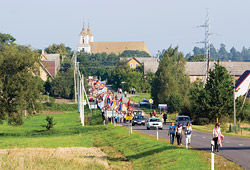History
The town of Tytuvėnai began to develop in the 17th century after Bernardine monks settled here in 1614. Their baroque-style stone church was blessed in 1635, and monastery buildings grew up around it, forming a complex that was at the centre of the town’s spiritual, cultural and commercial life.
Tytuvėnai suffered greatly during a war with the Swedes between 1655 and 1660, as well as during the Great Northern War. In 1701, the Swedes captured the town, while in 1708 Russian soldiers broke into the monastery, killed several monks and robbed the church’s treasury. The 1730s saw the start of reconstruction works that would continue until the end of the century, adding some new buildings and changing the appearance of others. Two towers and an entryway were added to the western façade of the church in 1735. A novitiate was established in the monastery in 1736, though construction of the stone novitiate building took place only in 1764–1770. It was adjoined to the northwest corner of the monastery.
The interior of the Tytuvėnai Church of Our Lady of the Angels was redone over two decades beginning about 1750, creating an array of nine magnificent late baroque altars. A new baroque organ was installed in 1789. The churchyard, including a walkway for processions, was put in place between about 1760 and 1780. In the centre of the churchyard there rose up the Chapel of the Stairs of Christ, or “Holy Steps Chapel”, with its Altar of Jesus Christ Crucified. A gallery with the Stations of the Cross was installed between 1771 and 1780 on the wall that encloses the churchyard.
The residents of Tytuvėnai took part in the 1863 uprising against the Tsarist regime. The insurgents fought against the Russian army in the town’s proximity at least three times. The monastery was closed in 1864, and its library was removed, due to suspicions that the monks had taken part in the uprising, or at least supported it. Then in 1868, an order was given to turn the Tytuvėnai church and all related buildings over to the Orthodox. However, thanks to the efforts of Bishop Motiejaus Valančiaus (1801–1875), the Catholics were able to keep possession of the church. The parish took over part of the closed monastery complex, but the rest fell into disrepair. In 1887, the Tsarist authorities ordered the demolition of the novitiate building and of some other structures, including the water mill and dam. As a result, the pond dried up, the gardens withered and fruit trees around the church, monastery and churchyard wasted away.
In the 1920s and 1930s, Tytuvėnai gained popularity as a place to spend the summer holidays. In order to attract more tourists, local residents beautified the town, transforming the marketplace across from the church into a park, paving the streets, laying sidewalks and planting trees along the roadside.
The Tytuvėnai complex was put to varied uses during the Soviet era. From 1950 to 1959, it housed a variety of administrative bodies. Beginning in 1959, the monastery buildings contained an agricultural institute and a boarding school. Restoration and repairs were undertaken between 1961 and 1973. The foundations and vaults were strengthened, the roofs were replaced and the buildings were painted inside and out. The outside of the Holy Steps Chapel was restored in 1968, and in 1973, under the direction of the Lithuanian art conservation specialist Vladas Drėma, the church’s interior and the galleries were renovated.
Today the former Bernardine monastery and church are among the most valuable religious architecture ensembles in Lithuania and all of northeast Europe. The complex, which developed and flourished in the 17th and 18th centuries only to suffer neglect over the 19th and 20th centuries, has maintained its religious significance and still preserves many significant specimens of ecclesiastical art. In 1995, a bust of the poet Maironis (1862–1932) was placed in the public square of Tytuvėnai and a monument to the victims of genocide was installed in the church’s courtyard.








